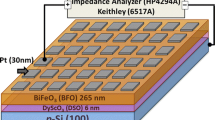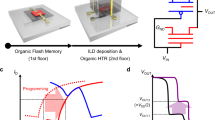Abstract
This article reports transparent bottom gate ZnO TFT based single transistor nonvolatile memory (NVM). Here current voltage hysteresis of this TFT structure has been thoroughly explored, where acceptor trap in the channel captures electrons during forward scanning resulting into threshold voltage hike in reverse scanning. This mobile charge carrier capture and release at the channel and oxide interface have been implicated in hysteresis. Additionally, it is validated using different geometrical and device parameter variations of TFT, such as channel length, temperature variation, oxide thickness, and energy level. The current ION/IOFF ratio was found to be in the range of ~ 109, which was responsible for the rapid switching memory speed. In addition, it was observed that the threshold voltage is impacted by programming and erase operations for various time steps. Moreover, the prospective use of the proposed NVM had a retention time for memory more than 10 years.






Similar content being viewed by others
Data availability
All the data used in this manuscript and will be made available if required.
References
H. You, W. Cho, Nonvolatile Poly-Si TFT Charge-Trap Flash Memory with Engineered tunnel barrier. IEEE Electron. Device Lett. 33, 170–172 (2012). https://doi.org/10.1109/LED.2011.2177060
T.H. Hsu, H.T. Lue, Y.C. King et al., A high-performance body-tied FinFET Bandgap Engineered SONOS (BE-SONOS) for NAND-type flash memory. IEEE Electron. Device Lett. 28, 443–445 (2007). https://doi.org/10.1109/LED.2007.895421
T.C. Chen, T.C. Chang, F.Y. Jian et al., Improvement of memory state misidentification caused by trap-assisted GIDL current in a SONOS-TFT memory device. IEEE Electron. Device Lett. 30, 834–836 (2009). https://doi.org/10.1109/LED.2009.2023827
E.M.C. Fortunato, P.M.C. Barquinha, A.C.M.B.G. Pimentel et al., Fully transparent ZnO thin-film transistor produced at room temperature. Adv. Mater. 17, 590–594 (2005). https://doi.org/10.1002/adma.200400368
M. Wang, X. Li, X. Xiong et al., High-Performance Flexible ZnO Thin-Film transistors by Atomic Layer Deposition. IEEE Electron. Device Lett. 40, 419–422 (2019). https://doi.org/10.1109/LED.2019.2895864
S. Deng, R. Chen, G. Li et al., Investigation of high-performance ITO-stabilized ZnO TFTs with hybrid-phase microstructural channels. IEEE Trans. Electron. Devices. 64, 3174–3182 (2017). https://doi.org/10.1109/TED.2017.2711199
S.M. Evans, N.C. Giles, L.E. Halliburton, L.A. Kappers, Further characterization of oxygen vacancies and zinc vacancies in electron-irradiated ZnO. J. Appl. Phys. 103 (2008). https://doi.org/10.1063/1.2833432
N. Zhang, W. Zhao, X. Zhang et al., Transparent floating gate memory based on ZnO Thin Film Transistor with controllable memory window. IEEE J. Electron. Devices Soc. 10, 275–280 (2022). https://doi.org/10.1109/JEDS.2022.3159787
J.S. Kim, S. Kang, Y. Jang et al., Investigating the reasons for the difficult erase operation of a charge-trap flash memory device with amorphous Oxide Semiconductor Thin-Film Channel Layers. Phys. Status Solidi - Rapid Res. Lett. 15, 1–7 (2021). https://doi.org/10.1002/pssr.202000549
F.B. Oruc, F. Cimen, A. Rizk et al., Thin-film ZnO charge-trapping memory cell grown in a single ALD step. IEEE Electron. Device Lett. 33, 1714–1716 (2012). https://doi.org/10.1109/LED.2012.2219493
L. Perniola, S. Bernardini, G. Iannaccone et al., Analytical model of the effects of a nonuniform distribution of stored charge on the electrical characteristics of discrete-trap nonvolatile memories. IEEE Trans. Nanotechnol. 4, 360–368 (2005). https://doi.org/10.1109/TNANO.2005.847033
B.B. Kumar, P.K. Tiwari, S. Dubey, K. Singh, Design and investigation of ZnO based thin film transistors for high-speed AMLCD pixel circuit applications. Micro Nanostruct. 164 (2022). https://doi.org/10.1016/j.spmi.2021.107122
Y.S. Park, J.S. Lee, Design of an efficient charge-trapping layer with a built-in tunnel barrier for reliable organic-transistor memory. Adv. Mater. 27, 706–711 (2015). https://doi.org/10.1002/adma.201404625
K.J. Yoon, Y. Kim, C.S. Hwang, What will come after V-NAND—Vertical Resistive switching memory? Adv. Electron. Mater. 5, 1–15 (2019). https://doi.org/10.1002/aelm.201800914
S.J. Ding, X. Wu, Superior Atomic Layer Deposition Technology for Amorphous Oxide Semiconductor Thin-Film Transistor Memory devices. Chem. Mater. 32, 1343–1357 (2020). https://doi.org/10.1021/acs.chemmater.9b03237
A. Sheikholeslami, P.G. Gulak, S. Member, A Survey of Circuit innovations in Ferroelectric Random-Access Memories. Proc. IEEE. 88, 667–689 (2000)
E. Kim, Y. Kim, D. Han Kim et al., SiNx charge-trap nonvolatile memory based on ZnO thin-film transistors. Appl. Phys. Lett. 99, 23–26 (2011). https://doi.org/10.1063/1.3640221
M.S. Oh, K. Lee, J.H. Song et al., Improving the Gate Stability of ZnO Thin-Film transistors with Aluminum Oxide Dielectric Layers. J. Electrochem. Soc. 155, H1009 (2008). https://doi.org/10.1149/1.2994629
Z. Ye, Y. Yuan, H. Xu et al., Mechanism and origin of Hysteresis in Oxide Thin-Film Transistor and its application on 3-D nonvolatile memory. IEEE Trans. Electron. Devices. 64, 438–446 (2017). https://doi.org/10.1109/TED.2016.2641476
K. Kandpal, N. Gupta, J. Singh, C. Shekhar, Study of ZnO / BST interface for thin-film transistor (TFT) applications. Surf. Interfaces. 23, 100996 (2021). https://doi.org/10.1016/j.surfin.2021.100996
J.Y. Bak, S.J. Kim, C.W. Byun et al., Effects of thickness and geometric variations in the oxide gate stack on the nonvolatile memory behaviors of charge-trap memory thin-film transistors. Solid State Electron. 111, 153–160 (2015). https://doi.org/10.1016/j.sse.2015.06.003
Y. Li, X. Huang, C. Liao et al., A dynamic current hysteresis model for IGZO-TFT. Solid State Electron. 197, 10–14 (2022). https://doi.org/10.1016/j.sse.2022.108459
X. Ding, J. Zhang, J. Li et al., Influence of the InGaZnO channel layer thickness on the performance of thin film transistors. Superlattices Microstruct. 63, 70–78 (2013). https://doi.org/10.1016/j.spmi.2013.08.017
C. Chen, K. Abe, H. Kumomi, J. Kanicki, Density of states of a-InGaZnO from temperature-dependent field-effect studies. IEEE Trans. Electron. Devices. 56, 1177–1183 (2009). https://doi.org/10.1109/TED.2009.2019157
J. Martins, P. Bahubalindruni, A. Rovisco et al., Bias stress and temperature impact on InGaZnO TFTs and circuits. Mater. (Basel). 10, 1–10 (2017). https://doi.org/10.3390/ma10060680
X. Cheng, S. Lee, R. Chaji, A. Nathan, Device-circuit interactions and impact on TFT circuit-system design. IEEE J. Emerg. Sel. Top. Circuits Syst. 7, 71–80 (2017). https://doi.org/10.1109/JETCAS.2016.2621348
C. Huang, M. Chen, C. Yu, T. Wan, Dual functional photo-response for p-Si/SiO2/n-InGaZnO graphene nanocomposites photodiodes. Nanotechnology. 29, 505202 (2018). https://doi.org/10.1088/1361-6528/aae474
T.N. Nguyen, S. Jung, V.D. Nguyen, J. Yi, Memory characteristics of poly-Si using MIC as an active layer on glass substrates. J. Phys. D Appl. Phys. 43 (2010). https://doi.org/10.1088/0022-3727/43/10/105406
N.C. Su, S.J. Wang, A. Chin, A nonvolatile InGaZnO charge-trapping-engineered flash memory with good retention characteristics. IEEE Electron. Device Lett. 31, 201–203 (2010). https://doi.org/10.1109/LED.2009.2037986
Y.S. Park, S.Y. Lee, J.S. Lee, Nanofloating gate memory devices based on controlled metallic nanoparticle-embedded InGaZnO TFTs. IEEE Electron. Device Lett. 31, 1134–1136 (2010). https://doi.org/10.1109/LED.2010.2063013
J. Jang, J.C. Park, D. Kong et al., Endurance characteristics of amorphous-InGaZnO transparent flash memory with gold nanocrystal storage layer. IEEE Trans. Electron. Devices. 58, 3940–3947 (2011). https://doi.org/10.1109/TED.2011.2164252
S. Chen, X.M. Cui, S.J. Ding et al., Novel zn-doped Al2O3 charge storage medium for light-erasable in-Ga-Zn-O TFT memory. IEEE Electron. Device Lett. 34, 1008–1010 (2013). https://doi.org/10.1109/LED.2013.2266371
J.Y. Bak, M.K. Ryu, S.H.K. Park et al., Impact of charge-trap layer conductivity control on device performances of top-gate memory thin-film transistors using IGZO channel and ZnO charge-trap layer. IEEE Trans. Electron. Devices. 61, 2404–2411 (2014). https://doi.org/10.1109/TED.2014.2318751
W.P. Zhang, S.B. Qian, W.J. Liu et al., Novel multi-level cell TFT memory with an In-Ga-Zn-O Charge Storage Layer and Channel. IEEE Electron. Device Lett. 36, 1021–1023 (2015). https://doi.org/10.1109/LED.2015.2466084
S.B. Qian, W.P. Zhang, W.J. Liu, S.J. Ding, (2015) Electrically programmable-erasable In-Ga-Zn-O thin-film transistor memory with atomic-layer-deposited Al2O3/Pt nanocrystals/Al2O3 gate stack. AIP Adv 5:. https://doi.org/10.1063/1.4937422
D.J. Yun, H.B. Kang, S.M. Yoon, Process optimization and device characterization of nonvolatile charge trap memory transistors using In-Ga-ZnO Thin films as both charge trap and active Channel Layers. IEEE Trans. Electron. Devices. 63, 3128–3134 (2016). https://doi.org/10.1109/TED.2016.2580220
S.B. Qian, Y.P. Wang, Y. Shao et al., Plasma-assisted atomic layer deposition of high-density ni nanoparticles for amorphous In-Ga-Zn-O Thin Film Transistor Memory. Nanoscale Res. Lett. 12 (2017). https://doi.org/10.1186/s11671-017-1925-z
M.K. Hota, F.H. Alshammari, K.N. Salama, H.N. Alshareef, Transparent flash memory using single Ta2O5 layer for both charge-trapping and tunneling dielectrics. ACS Appl. Mater. Interfaces. 9, 21856–21863 (2017). https://doi.org/10.1021/acsami.7b03078
D.D. Liu, W.J. Liu, J.X. Pei et al., Voltage-polarity Dependent Programming behaviors of Amorphous In–Ga–Zn–O Thin-Film Transistor memory with an atomic-layer-deposited ZnO charge trapping layer. Nanoscale Res. Lett. 14 (2019). https://doi.org/10.1186/s11671-019-3204-7
N. Zhang, W. Zhao, C. Yao et al., Transparent multi-level NAND flash memory and circuits based on ZnO Thin Film Transistor. IEEE Electron. Device Lett. 44, 610–613 (2023). https://doi.org/10.1109/LED.2023.3248068
Acknowledgements
NA
Funding
No funding.
Author information
Authors and Affiliations
Contributions
Binay Binod Kumar, Solid State Electronics and VLSI Design Lab, Department of ECE, NIT Jamshedpur, Jharkhand, carried out TCAD simulation reported in paper, manuscript preparation. Dr. Kunal Singh, Solid State Electronics and VLSI Design Lab, Department of ECE, NIT Jamshedpur, Jharkhand, final draft of manuscript check and made graphs
Corresponding author
Ethics declarations
Ethics Approval
NA.
Consent to Participate
Yes.
Consent for Publication
Yes.
Competing Interests
All authors have participated in (a) conception and design, or analysis and interpretation of the data; (b) drafting the article or revising it critically for important intellectual content; and (c) approval of the final version. This manuscript has not been submitted to, nor is under review at, another journal or other publishing venue. The authors have no affiliation with any organization with a direct or indirect financial interest in the subject matter discussed in the manuscript. The following authors have affiliations with organizations with direct or indirect financial interest in the subject matter discussed in the manuscript: Binay Binod Kumar, Solid State Electronics and VLSI Lab, Department of ECE, NIT Jamshedpur, Jharkhand. Dr. Kunal Singh, Solid State Electronics and VLSI Lab, Department of ECE, NIT Jamshedpur, Jharkhand.
Additional information
Publisher’s Note
Springer Nature remains neutral with regard to jurisdictional claims in published maps and institutional affiliations.
Rights and permissions
Springer Nature or its licensor (e.g. a society or other partner) holds exclusive rights to this article under a publishing agreement with the author(s) or other rightsholder(s); author self-archiving of the accepted manuscript version of this article is solely governed by the terms of such publishing agreement and applicable law.
About this article
Cite this article
Kumar, B.B., Singh, K. Consistent Performance ZnO TFT Based Single Transistor Nonvolatile Memory with Minimal Charge Loss. Trans. Electr. Electron. Mater. (2024). https://doi.org/10.1007/s42341-024-00519-2
Received:
Revised:
Accepted:
Published:
DOI: https://doi.org/10.1007/s42341-024-00519-2




